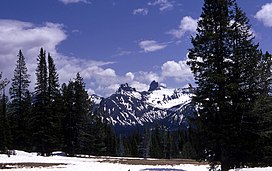South Central Rockies forests
| South Central Rockies forests | |
|---|---|
 Subalpine forest in Shoshone National Forest, Wyoming | |
 | |
| Ecology | |
| Realm | Nearctic |
| Biome | Temperate coniferous forest |
| Borders | List
|
| Bird species | 201[1] |
| Mammal species | 99[1] |
| Geography | |
| Country | United States |
| States | |
| Conservation | |
| Habitat loss | 1.6644%[1] |
| Protected | 82.66%[1] |
The South Central Rockies forests is a
Setting
This ecoregion is located mainly in western
Flora
The ecoregion is predominantly
Fauna
Mammals of this ecoregion include elk (Cervus canadensis), mule deer (Odocoileus hemionus), bighorn sheep (Ovis canadensis), plains bison (Bison bison bison), Shiras moose (Alces alces shirasi), cougar (Puma concolor), grizzly bear (Ursus arctos horribilis), northwestern wolf (Canis lupus occidentalis), black bear (Ursus americanus cinnamomum), bobcat (Lynx rufus) and Canada lynx (Lynx canadensis), coyote (Canis latrans), North American beaver (Castor canadensis), North American river otter (Lontra canadensis), and snowshoe hare (Lepus americanus).[2]
Birds are typical of the forested portions of the northern Rocky Mountains, including
Conservation status and protected areas
Though large portions of this ecoregion are protected, its conservation status is listed as "vulnerable". Indiscriminate logging of unprotected areas and the deaths of grizzly bears and possibly wolves by ungulate hunters are the main threats to this ecoregion's integrity. Protected areas include Yellowstone National Park in northwestern Wyoming, south-central Montana and eastern Idaho, Grand Teton National Park in western Wyoming, Cloud Peak Wilderness in north-central Wyoming, and Black Elk Wilderness in southwestern South Dakota.
See also
References
- ^ a b c d "Atlas of Global Conservation". The Nature Conservancy. Retrieved 2017-05-08.
- ^ a b "South Central Rockies forests". Terrestrial Ecoregions. World Wildlife Fund.
- ^ a b
 This article incorporates public domain material from "Chapter 43: Southern Rocky Mountain Steppe - Open Woodland - Coniferous Forest - Alpine Meadow". Ecological Subregions of the United States. United States Forest Service. Retrieved 2019-06-20.
This article incorporates public domain material from "Chapter 43: Southern Rocky Mountain Steppe - Open Woodland - Coniferous Forest - Alpine Meadow". Ecological Subregions of the United States. United States Forest Service. Retrieved 2019-06-20.
